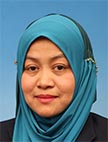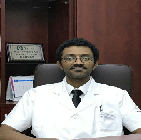Day 1 :
Keynote Forum
Wan Zaripah Wan Bakar
Universiti Sains Malaysia, Malaysia
Keynote: Hardness assessment of new modified glass ionomer cement nanosilica- hydroxyapatite-zirconia composite using one-pot technique
Time : 10:00-11:00

Biography:
Wan Zaripah Wan Bakar has graduated in 1992 and served the Ministry of Health, Malaysia for 9 years. She has completed Graduate Diploma in Clinical Dentistry in 2003, Doctor of Clinical Dentistry in 2006 from University of Adelaide, Australia and is also a Fellow of RACDS since 2004. In 2013, she did her Postdoctoral Research Fellow Program at the UTHSCSA, Texas, USA. She currently works as Senior Lecturer and Consultant Prosthodontist/Restoratives at Universiti Sains Malaysia, Malaysia. She has published more than 30 papers in reputed journals.
Abstract:
Glass ionomer cement is among the commonly used material in dentistry but has some limitation such as low hardness and wear resistance which has trigger researchers to modify its powder composition. One-pot synthesis method was used to prepare new nanopowder hybrids of nanosilica-hydroxyapatite-zirconia (nanoSi-HA-Zr). This new nanopowder hybrid was added into commercial available conventional glass ionomer powder (Fuji IX, GC, Japan) at weight percentages of 1%, 3% and 5% by spatulation at controlled grinding process to produce GIC-nanosilica- hydroxyapatite-zirconia (GIC-nanoSi-HA-Zr). Vickers hardness of the new composite were assessed and compared with the Fuji IX and GIC-nanoSi-HA (GIC-nanoSi-HA) hybrid. In general, results showed that the hardness of GIC-nanoSi-HA-Zr composite was higher than Fuji IX and GIC-nanoSi-HA composite. The highest hardness values recorded is at 3% addition for GIC-nanoSi-HA-Zr which is ~75 HV (±2.48) compared to ~51 HV (±4.45) Fuji IX and ~56 HV (±6.67) GIC-nanoSi-HA. It could be concluded that incorporation of nanozirconia significantly improves the hardness of conventional glass ionomer and also GIC-nanoSi-HA.
Keynote Forum
Dharmasindhu Rai
Jerudong Park Medical Centre, Brunei
Keynote: Health, Safety and Infection control in dental laboratory
Time : 11:15-12:15

Biography:
Dharmasindhu Rai is a firm believer in taking a holistic approach to dentistry, focusing not only on restoring the functional capabilities of the patient but also restoring the balance and smile. He is specialized in crowns, bridges, dentures and also maintains his skills for general dental work like fillings, simple extractions, pain management, teeth whitening and patient education. He keeps abreast of dental techniques and technologies with continuing education.
Abstract:
Health, safety and infection control in dental laboratory is often an overlooked area and yet an important aspect for any dental practice. The use of appropriate infection control precautions is important for the dental technicians, as it is for the dental team. Improper handling of contaminated items, such as impressions, casts and other prosthetic appliances can result in cross contamination and possible cross infection to personnel and patients. A work environment which is safe to health is equally important for the dental technicians to produce quality work. This presentation will address all these issues along with our experience in implementing these changes towards JCI accreditation at Jerudong Park Medical Centre Dental Laboratory in Brunei Darussalam.
- Orthodontics and Dentofacial Orthopaedics | Oral Implants Research | Periodontology and Restorative Dentistry
Location: A

Chair
Wan Zaripah Wan Bakar
Universiti Sains Malaysia, Malaysia
Session Introduction
Kholoud Alahdal
Security Forces Hospital, KSA
Title: Ceramic Veneers where to start from and how to decide

Biography:
Abstract:

Biography:
Abstract:
Yassir Abdelrahman Hag Elkhidir
Suihua Stomatological Hospital, China
Title: The osteogenic effect of photofunctionalization on gold nanoparticles applied on biomimetic titanium surfaces

Biography:
Dr.Yassir has completed his MDS in oral surgery and Implantology in 2014 at Huazhong university of Science and technology and was awarded the full PhD scholarship for outstanding students. Upon completion in 2017, he was the first Sudanese to obtain such a degree in the field of Oral Implantology. His works on titanium surface modification has resulted in remarkable improvements in the speed and extent of bone regeneration. Currently he is working in the department of oral implantology and dentofacial surgery at Suihua, the first affiliated stomatological hospital of Jinan University - Guangzhou, P.R.China.
Abstract:
Objectives: The aims of this study were to create a new surface topography using simulated body fluids (SBF) and gold nanoparticles (GNPs), to assess the osteogenic effect of the new surface on osteoblastic differentiation with and without UV photofunctionalization.
Materials & Methods: Commercially pure titanium plates (cpTiO2) were divided into six groups with different modifications. All 6 groups were acid etched with 67% sulfuric acid (H2SO4), four were immersed in simulated body fluid (SBF) for 24 hours to create a hydroxyapatite layer and two groups were treated with 13 nm gold nanoparticles (GNPs) for 24 hours. Half of the TiO2 plates were photofunctionalized (PhF) with UV light for 48 hours to be compared with the non-PhF ones. The main experimental groups were 3B which had H2SO4+SBF+GNPs+PhF and 2B which had the same treatment except for GNPs. Rat’s bone marrow stem cells (rBMSCs) were seeded into the plates and then CCK8 assay, cell viability (live/dead) assay, immunofluorescence and electron scanning microscopy were done after 24 hours. Gene expression analysis was done using real time quantitative PCR (qPCR) was done 1 week later to check for the mRNA expression of Collagen-1 (Col-1), Osteopontin (OPN) and Osteocalcin (OCN). Alkaline phosphatase (ALP) activity was performed after 2 weeks of cell seeding.
Results: Results were analyzed using Prism 5.0 statistical package. One-way analysis of variance was done for multiple comparisons and t-tests for individual comparisons. 3B which had all the treatment modalities showed the highest results and was compared to the closest group 2B. Optical density was almost 50% higher than the control group and significantly higher than 2B with a P value <0.0156) in 2B to 79% (p value <0.0147) in 3B. qPCR results showed the highest increase in the expression of osteogenic genes in 3B. When compared to 2B, 3B showed a significant increase in the expression of all the genes with P values of 0.0238, 0.0238 and 0.0038 for Col-1, OPN and OCN, respectively. 3B also showed just above 20% more increase in the ALP activity when compared to 2B.
Conclusion: We have created a novel hybrid micro-nano titanium surface. TiO2 plates were acid etched, coated with a hydroxyapatite layer using SBF to create biomimetic topography, photofunctionalized and seeded with 13 nm gold nanoparticles. This new surface has a remarkably more osteogenic potential than other surface treatments. The 13 nm GNPs did not show any cytotoxicity. Imunoflourescence and ESM results showed that it highly increased the rate of differentiation, proliferation, attachment, spreading and mineralization. PCR results showed enhanced gene expressions of Col-1, OPN and OCN osteogenic markers. ALP activity was also higher than the other groups. GNPs play an important role in cellular activity and growth. Photofunctionalizing GNPs highly increases its ostogenic capabilities. Our novel topography might be the most biocompatible titanium surface treatment up to date and it may have a good potential in further enhancing the osseointegration process and improving outcomes for maxillofacial and orthopedic patients.
Severine Anthony
Copperbelt University, Zambia
Title: Periodontal health status and treatment needs among psychiatric patients attending Ndola Central Hospital, Zambia

Biography:
Abstract:
- Endodontics | Dental Research | Clinical and Experimental Dentistry

Chair
Jukka P Matinlinna
The University of Hong Kong, Hong Kong

Biography:
Abstract:
Wan Zaripah Wan Bakar
Universiti Sains Malaysia, Malaysia
Title: Interractive lecture and the acceptance level among lecturers in PPSG, USM, Malaysia

Biography:
Abstract:
Yassir Elkhidir
Suiwah Stomatological Hospital, China
Title: Ultraviolet Photofunctionalization for Speed Osseointegration

Biography:
Abstract:
- Endodontics | Dental Research | Clinical and Experimental Dentistry

Chair
Jukka P Matinlinna
The University of Hong Kong, Hong Kong

Biography:
Abstract:
Wan Zaripah Wan Bakar
Universiti Sains Malaysia, Malaysia
Title: Interractive lecture and the acceptance level among lecturers in PPSG, USM, Malaysia

Biography:
Abstract:
Yassir Elkhidir
Suiwah Stomatological Hospital, China
Title: Ultraviolet Photofunctionalization for Speed Osseointegration

Biography:
Abstract:
Aditi Jain
Ayush University of Medical Science, India
Title: Antibacterial efficacy of neem, triphala, green tea and combination of neem with triphala extract against Enterococcus faecalis: An in vitro study

Biography:
Abstract:
Sanjeev Kunhappan
Government Dental College, India
Title: Taming the “LEO†(Lesion of Endodontic Origin)

